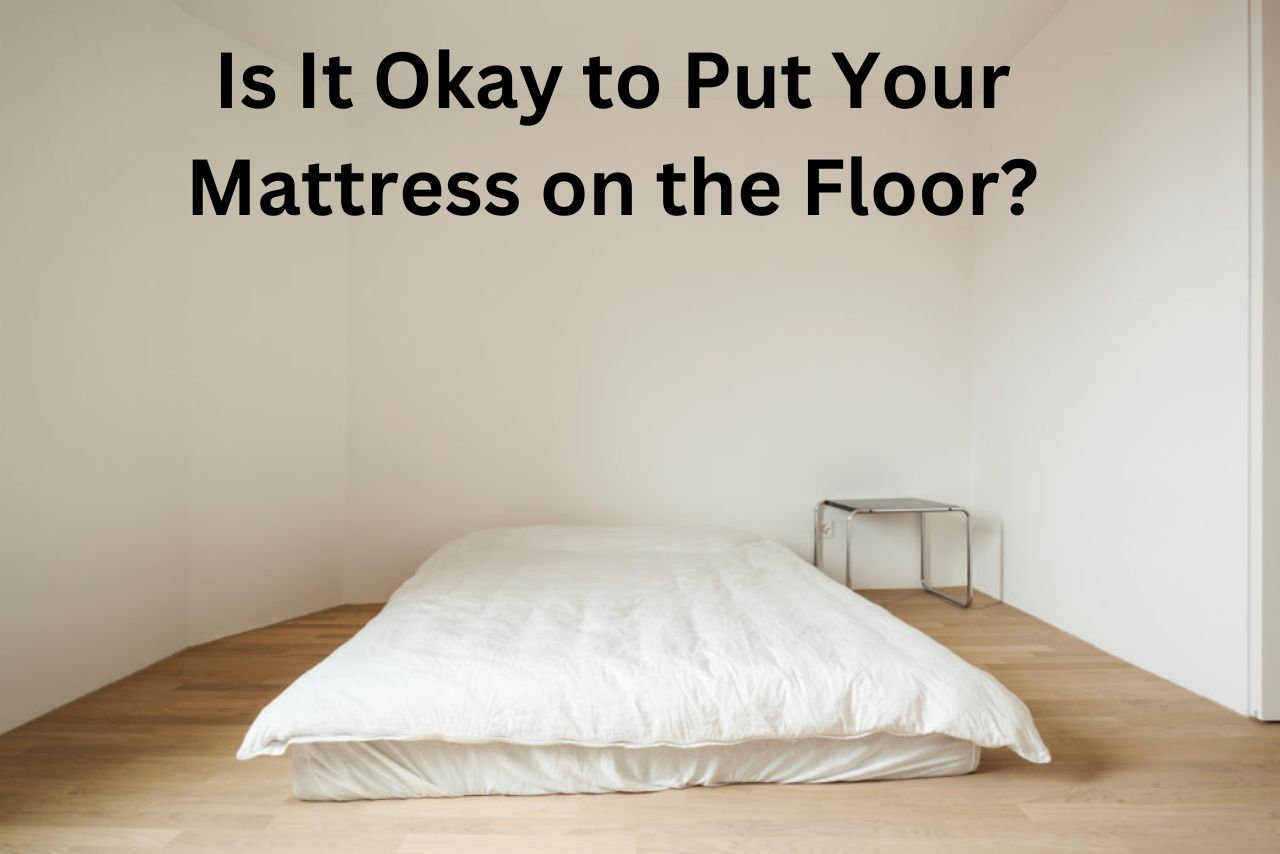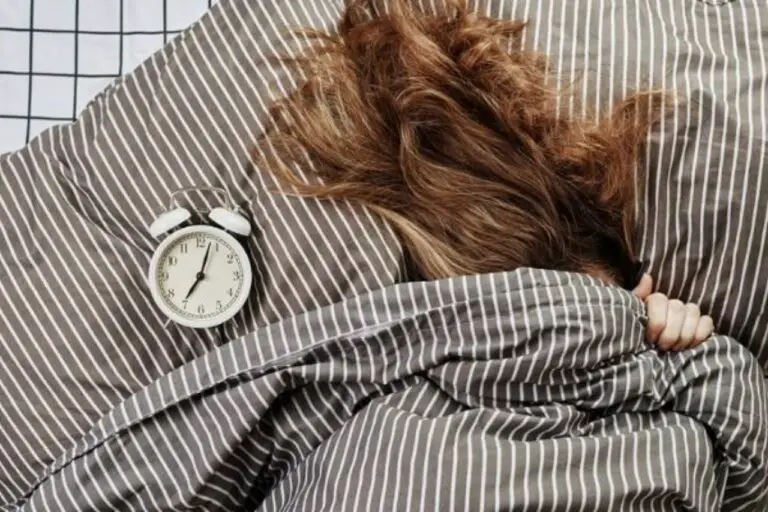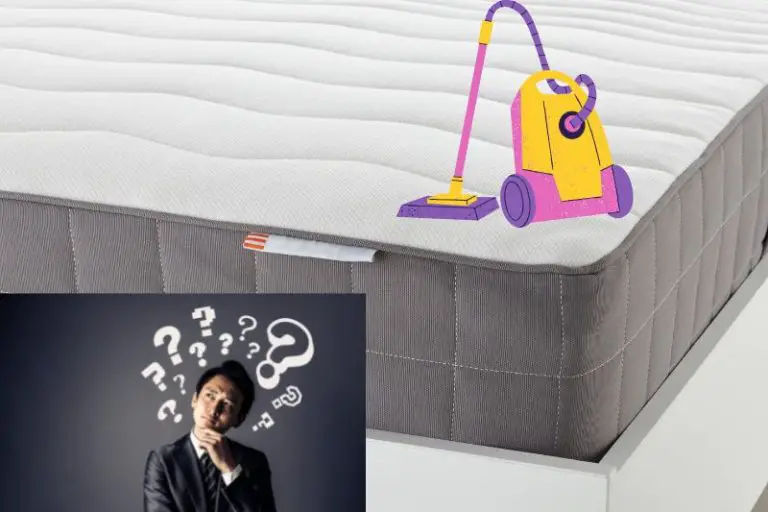Is It Okay to Put Your Mattress on the Floor?

Many people wonder if this alternative sleeping arrangement is acceptable.
Is It Okay to Put Your Mattress on the Floor?
Yes, putting your mattress on the floor is generally okay, but there are considerations. It can impact airflow and potentially lead to mold or mildew if the mattress is placed directly on a non-breathable surface. Using a breathable mattress pad or platform can mitigate these issues and provide better support.
It is generally okay to put your mattress directly on the floor.
In this article, we will explore the pros and cons of putting your mattress on the floor and provide you with helpful tips for making this unconventional setup work for you.
So let’s dive in and find out if putting your mattress on the floor is a suitable option for your sleep environment.
Benefits of Putting Your Mattress on the Floor:
Putting your mattress on the floor might not be a conventional choice, but it does come with some benefits.
Here are a few reasons why you might consider this option:
- Cost-effective: Placing your mattress directly on the floor eliminates the need for a bed frame or box spring, saving you money. This can be especially beneficial if you’re on a tight budget.
- Space-saving: If you have limited space in your bedroom, placing your mattress on the floor can help maximize it. Without a bulky bed frame, you’ll have more room to move around and store other items.
- Minimalist aesthetic: For those who prefer minimalistic design or embrace an uncluttered look, having just a mattress on the floor can create a clean and simple aesthetic that fits their style.
- Easy accessibility: With no raised platform or bed frame to navigate, getting in and out of bed becomes easier—especially for individuals with mobility issues or injuries. It also makes it convenient for young children transitioning from cribs to beds.
- Cooler sleeping surface: Sleeping closer to the ground can provide cooler temperatures during hot summer nights since heat tends to rise. This may contribute to better sleep quality and comfort without excessive sweating.
It’s worth noting that there are also some considerations when deciding whether putting your mattress directly onto the floor is right for you:
- Lack of airflow: Placing your mattress directly on the floor may restrict air circulation underneath, potentially leading to moisture buildup and mold growth over time.
- Increased exposure: Being closer to dust and allergens present at ground level could affect individuals with allergies or respiratory conditions.
- Comfort level: Some people find mattresses placed directly on floors less comfortable due to lack of support compared to traditional setups using bed frames or box springs.
- Temperature regulation: While cooler temperatures are advantageous in warm climates, sleeping close to the floor might make the mattress colder during winter months, requiring additional insulation.
Ultimately, whether or not it’s okay to put your mattress on the floor depends on your personal preferences and circumstances.
Considering both the benefits and potential drawbacks will help you make an informed decision that suits your needs.
Drawbacks of Putting Your Mattress on the Floor:
Putting your mattress directly on the floor may seem like a convenient and cost-effective solution, but it comes with its fair share of drawbacks.
Here are some reasons why you might want to think twice before ditching your bed frame:
- Lack of airflow: Placing your mattress on the floor restricts proper air circulation, which can lead to increased moisture buildup. This trapped moisture can create an ideal breeding ground for mold and mildew, posing potential health risks.
- Increased exposure to dust: Without a raised platform or bed frame, your mattress is more susceptible to collecting dust from the floor. Dust mites thrive in this environment and can aggravate allergies or respiratory issues.
- Poor temperature regulation: Sleeping closer to the ground means being subject to fluctuating temperatures. In colder seasons, the lack of insulation from underneath may make you feel colder than if you were sleeping higher up where heat rises.
- Limited storage space: Placing your mattress directly on the floor eliminates valuable under-bed storage options that come with having a bed frame or base. This can be particularly inconvenient if you have limited space in your bedroom.
- Potential pest problems: By keeping your mattress low to the ground, you increase its vulnerability to pests such as rodents and insects that might find their way into your living space more easily.
- Difficulty getting in and out of bed: A lower sleeping surface makes it harder for some individuals, especially those with mobility issues or back problems, to get in and out of bed comfortably.
While putting your mattress on the floor may work temporarily as a quick fix or during certain circumstances (such as moving), it’s important to consider these drawbacks before making it a permanent setup in order to maintain optimal sleep conditions and overall hygiene in your bedroom.
Is It Healthy to Put Your Mattress on the Floor?
Putting your mattress directly on the floor may seem like a simple and cost-effective solution, but is it actually healthy? Let’s take a closer look at the potential benefits and drawbacks of this sleeping setup.
Benefits of Putting Your Mattress on the Floor:
- Firmness: Placing your mattress on a hard surface like the floor can provide extra firmness, which some people prefer for better back support.
- Minimalism: If you embrace a minimalist lifestyle or have limited space, putting your mattress on the floor can help create an uncluttered and streamlined bedroom aesthetic.
- Stability: By eliminating bed frames or platforms, you reduce the risk of squeaky noises or wobbly structures that can disrupt your sleep.
Drawbacks of Putting Your Mattress on the Floor:
- Hygiene Concerns: Without proper elevation from the floor, mattresses are more susceptible to dust mites, allergens, and mold accumulation over time. Adequate ventilation becomes crucial in preventing these issues.
- Temperature Regulation: A mattress placed directly on the floor may not receive sufficient airflow underneath it, potentially leading to heat retention and discomfort during hot weather conditions.
- Moisture Accumulation: Floors often contain moisture from various sources such as spills or condensation. When a mattress is in direct contact with such surfaces for an extended period, it can absorb moisture and develop mold or mildew if not adequately aired out.
To determine whether placing your mattress on the floor is suitable for you personally, consider factors such as climate conditions, room ventilation options, personal comfort preferences regarding firmness level/supportiveness needed for quality sleep.
While putting your mattress directly onto the floor has its pros and cons concerning health aspects mentioned above ensuring proper cleanliness measures through regular cleaning/vacuuming beneath it while being cautious about dampness and adequate ventilation can help mitigate potential drawbacks.
How to Properly Prepare Your Floor for a Mattress?
When placing your mattress on the floor, it’s important to take certain steps to ensure optimal comfort and longevity.
Here are some simple yet effective ways to prepare your floor:
- Clean the area:
- Remove any dust, dirt, or debris from the surface where you plan to place your mattress.
- Vacuum or sweep the floor thoroughly.
- Consider mopping if necessary.
- Check for moisture:
- Ensure that there is no moisture buildup on the floor as it can lead to mold and mildew growth.
- Use a dehumidifier in humid environments.
- Address uneven surfaces:
- If your floor has bumps or uneven areas, try using a sander or filler to level out those spots.
- Provide insulation:
- To prevent heat loss and cold drafts from affecting your sleep quality, consider using an underlay beneath your mattress.
- Options like foam pads or carpet padding can provide additional cushioning and insulation.
- Protect against pests:
- Keep pests away by applying insect repellent around the perimeter of the sleeping area.
- Optimize airflow:
- Maintain proper ventilation by opening windows during daytime hours when weather permits,
- Use fans or air purifiers if needed.
- Enhance comfort with rugs: Place rugs near your bed area not only add warmth but also create a defined space while protecting both your mattress and floor surface.
By following these preparation tips, you can maximize comfort and minimize potential issues when placing your mattress directly on the floor
Alternative Options to Consider Instead of Putting Your Mattress on the Floor
If you’re not keen on placing your mattress directly on the floor, there are several alternative options that can provide both comfort and style.
Here are some ideas to consider:
- Platform Bed: A platform bed offers a low-profile sleeping surface without sacrificing support. These beds feature a solid base or slats that eliminate the need for a box spring. With various designs available, you can find one that suits your aesthetic preferences.
- Bed Frame with Legs: Opting for a bed frame with legs raises your mattress off the ground while adding stability. Look for frames made from sturdy materials like metal or wood to ensure durability.
- Raised Platform: For those who enjoy the minimalist look of a mattress close to the floor but still want some elevation, consider building or purchasing a raised platform specifically designed for mattresses without any additional headboard or footboard.
- Mattress Foundation: Similar to box springs, mattress foundations offer height and support while maintaining proper airflow through their slatted construction.
- Bunkie Board: Ideal for those who prefer lower-profile beds, bunkie boards are thin platforms made of plywood or particle board that provide sufficient support while keeping your mattress closer to the ground.
- Adjustable Bed Base: If you’re after ultimate flexibility and customization, an adjustable bed base is worth considering. These bases allow you to change positions easily while providing ample height above the floor.
- Futon / Sofa Bed: In rooms where space is limited or used multifunctionally (e.g., guest room/office), futons and sofa beds serve as versatile alternatives by offering seating during daytime hours and transforming into comfortable bedding at night.
Remember, each option has its own advantages in terms of aesthetics, functionality, and cost-effectiveness—so choose what aligns best with your personal preferences and needs.
| Pros | Cons |
|---|---|
| Provides elevation and support for your mattress | May require additional assembly or purchasing of separate components |
| Offers various design options to complement your bedroom decor | Some options may be more expensive than others |
| Allows proper airflow around the mattress | Height may vary, so consider your desired level of accessibility |
By exploring these alternatives, you can find a suitable solution that elevates both your mattress and sleeping experience without resorting to placing it directly on the floor.
Tips for Making a Mattress on the Floor Look Stylish and Neat:
When it comes to placing your mattress directly on the floor, there are ways to make it look stylish and neat.
Follow these simple tips to elevate the aesthetic appeal of your bedroom:
- Invest in quality bedding: Choose luxurious sheets, cozy blankets, and decorative pillows that complement your room’s color scheme. Opt for high-quality materials like cotton or linen to create a chic and inviting atmosphere.
- Add a bed frame alternative: To give the illusion of a traditional bed setup, consider using low-profile furniture pieces like wooden pallets or sturdy storage containers as makeshift bed frames. Paint them in an appealing color or add some cushions for extra comfort.
- Layer with rugs: Place an area rug underneath your mattress to define the sleeping area and add warmth to the space. Experiment with different textures and patterns that match your overall decor style.
- Utilize wall art: Hang artwork above your mattress to draw attention away from its placement on the floor. Large statement pieces or gallery walls can act as focal points and distract from any perceived lack of sophistication.
- Create ambient lighting: Install wall sconces, string lights, or place table lamps strategically around the room to set a cozy ambiance while also illuminating your mattress area effectively.
- Incorporate nightstands: Consider adding small bedside tables or floating shelves next to your mattress for practicality and aesthetics alike. Display books, plants, or other decorative items that reflect your personal style.
- Keep it clean: Regularly vacuum under and around your mattress on the floor to prevent dust accumulation which could detract from its overall appearance.
Remember that styling a mattress on the floor is all about creativity and personal expression! Embrace this unconventional trend by infusing elements that resonate with you while maintaining cleanliness at all times.
What Type of Floors are Suitable for Placing a Mattress Directly?
When it comes to placing your mattress directly on the floor, not all types of floors are created equal.
Here’s a rundown of different flooring options and whether they can provide a suitable base for your mattress:
- Hardwood Floors: Hardwood floors are generally sturdy and durable, making them an excellent choice for placing your mattress directly on the floor. They offer solid support and stability.
- Laminate Flooring: Laminate flooring is also a viable option for placing your mattress on the floor. It resembles hardwood but is typically more cost-effective. Just ensure that the laminate is properly installed to avoid any unevenness or shifting.
- Tile Flooring: Tile floors can work well as long as they’re even and level. However, keep in mind that tiles tend to feel colder than other flooring materials, so you might want to use additional insulation beneath your mattress if warmth is a concern.
- Concrete Floors: Concrete floors may be common in basements or unfinished spaces where mattresses are often placed directly on the ground without any issues. If you have a polished concrete floor, consider using rugs or mats to add some cushioning between yourself and the firm surface.
- Carpeted Floors: While carpets provide added comfort underfoot, they may not be ideal for placing mattresses directly due to potential mold growth caused by trapped moisture from condensation underneath the bed.
- Vinyl Flooring: Vinyl flooring can work well if it’s smooth and levelled properly before putting down your mattress; however, note that vinyl tends to be less breathable compared to other options.
Remember that regardless of which type of floor you choose for placing your mattress directly, proper maintenance remains essential regularly clean both sides of the mattress (especially when closer contact with dust) and inspect the area underneath periodically for signs of dampness or damage.
Conclusion: Is It Okay to Put Your Mattress on the Floor?
In conclusion, putting your mattress on the floor can be a viable option for some individuals. It offers simplicity, affordability, and a minimalist aesthetic that appeals to many.
However, there are several factors to consider before making this decision.
Firstly, placing your mattress directly on the floor may not provide adequate support or ventilation.
This could result in discomfort and an increased risk of mold or mildew growth over time. Additionally, it may be more challenging to clean and maintain a mattress when it is placed on the floor.
Furthermore, if you have any existing health conditions such as back pain or arthritis, sleeping on a mattress at ground level might not offer the proper support your body needs. In such cases, using a bed frame or foundation would be recommended.
Ultimately, whether it is okay to put your mattress on the floor depends on personal preference and individual circumstances. If you choose this option, ensure proper airflow and cleanliness to promote healthy sleep hygiene.







